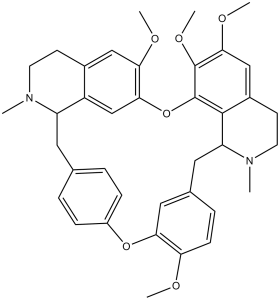This product is for research use only, not for human use. We do not sell to patients.

| Size | Price | Stock |
|---|---|---|
| 5g | $520 | In Stock |
| 10g | $850 | In Stock |
| 20g | $1275 | In Stock |
Cat #: V1232 CAS #: 518-34-3 Purity ≥ 98%
Description: Tetrandrine (also called Fanchinine; Sinomenine A; d-tetrandrine; formerly NSC-77037), a bis-benzylisoquinoline alkaloid derived from Stephania tetrandra, is a novel and potent calcium channel blocker which inhibits voltage-gated Ca2+ current (ICa) and Ca2+-activated K+ current.
Publications Citing InvivoChem Products
Product Promise

- Physicochemical and Storage Information
- Protocol
- Related Biological Data
- Stock Solution Preparation
- Quality Control Documentation
| Molecular Weight (MW) | 622.75 |
|---|---|
| Molecular Formula | C38H42N2O6 |
| CAS No. | 518-34-3 |
| Storage | -20℃ for 3 years in powder formr |
| -80℃ for 2 years in solvent | |
| Solubility In Vitro | DMSO: <1 mg/mLr |
| Water: <1 mg/mLr | |
| Ethanol: <1 mg/mL | |
| Synonyms | NSC 77037; Sinomenine A; d-tetrandrine; Fanchinine; Tetrandrine; NSC-77037; NSC77037; (S,S)-(+)-tetrandrine; TTD. |
| Protocol | In Vivo | To evaluate the effect of Tetrandrine (NSC-77037) on the inhibition of tumor metastasis in vivo, HCCLM9 subcutaneous tumor xenograft models is established with athymic nude mice. When the tumor volume reach approximately 50 mm3, nude mice are orally administered vehicle or Tetrandrine (NSC-77037) (30 mg/kg) every other day for 37 days. Tetrandrine (NSC-77037) treatment inhibits tumor growth by reducing the tumor volume and weight |
|---|
| Solvent volume to be added | Mass (the weight of a compound) | |||
|---|---|---|---|---|
| Mother liquor concentration | 1mg | 5mg | 10mg | 20mg |
| 1mM | 1.6058 mL | 8.0289 mL | 16.0578 mL | 32.1156 mL |
| 5mM | 0.3212 mL | 1.6058 mL | 3.2116 mL | 6.4231 mL |
| 10mM | 0.1606 mL | 0.8029 mL | 1.6058 mL | 3.2116 mL |
| 20mM | 0.0803 mL | 0.4014 mL | 0.8029 mL | 1.6058 mL |
This equation is commonly abbreviated as: C1 V1 = C2 V2
- (1) Please be sure that the solution is clear before the addition of next solvent. Dissolution methods like vortex, ultrasound or warming and heat may be used to aid dissolving.
- (2) Be sure to add the solvent(s) in order.




































